
From the publisher:
“For too long, Anti-Sicilian rhetoric has centred on the logic of simplicity, geared towards reaching playable positions with easy plans while simultaneously avoiding depths of theory. The danger of this logic is the ease with which we can fall into the trap of inactivity; of mindlessly playing an opening without striving to trouble Black; of solely playing an Anti-Sicilian to avoid theory. In contrast, throughout the volumes I will advocate an active approach – with continuous underlying themes of achieving rapid development, dynamic piece play and dominant central control, with an important focus on denying Black the counterplay that he seeks when choosing the Sicilian Defence.”

“Ravi Haria (born 1999) is one of England’s youngest International Masters, and the current holder of the British U21 title. Alongside his career as a chess player and trainer, Ravi reads History at University College London. This is his first book for Thinkers Publishing and his first book ever.”
As with every recent Thinkers Publishing publication high quality paper is used and the printing is clear. We were hoping that the excellent glossy paper of previous titles would be used for this one but never mind.
Each diagram is clear and the instructional text is typeset in two column format, which, we find, enables the reader to maintain their place easily. Figurine algebraic notation is used throughout and the diagrams are placed adjacent to the relevant text and each diagram has a “to move” indicator and a “position after: x move” type caption.
There is no Index or Index of Variations but, despite that, content navigation is relatively straightforward as the Table of Contents is detailed.
After

the main content is divided into five Parts viz:
- Sidelines
- 3…Nf6
- 3…d6
- 3…e6
- 3…g6
In the BCN office we have on our shelves
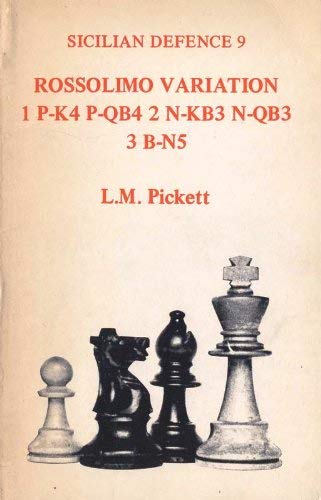
from 1977 and to spend 77 pages covering a third move minor alternative to the Open Sicilian (3.d4) was unusual for this time.
In 2021 we have the first book from IM Ravi Hari impressively weighing in at just under 1 kg and covering 520 densely packed pages.

In 2021 3.Bb5 is easily the second most popular alternative to Morphy’s 3.d4 Open Sicilian. Megabase 2020 (with updates) records 67354 games as against 246585 games for the “main line” so the market for a comprehensive treatise is overwhelmingly compelling.
Here is the detailed Table of Contents:

and here is an excerpt of the content.
Before we delve into the meat and potatoes here is a game from the author himself in this very line:
This superb book is suitable for anyone wishing to play a sound, dynamic system against 2…Nc6 in the Sicilian. The author stresses that the aim of the publication is to provide active lines to make black’s life difficult and stifle the counterplay that Sicilian players crave. Many of the world’s top players play this system including the current world champion, Magnus Carlsen.
I wouldn’t describe the book as a pure narrow repertoire book of the type “white to play and win against a particular opening” as it’s coverage of the opening is extensive and suggests alternative white systems against all of the main lines. As the author points out, this variation of opening preparation is vital to avoid being too predictable. Nevertheless, the title is targeted more towards the white side.
It is perfectly suitable for any club player who wishes to learn this system from scratch or any old hand of the the Rossolimo who wishes to refresh their opening knowledge. Despite my comment above, the volume is also extremely useful for a black player preparing against the Rossolimo.
One of the great strengths of the tome is the textual clarification of the ideas and plans; there is some dense analysis where necessary but it is accompanied with erudite explanation.
Part 1 covers the sidelines.
In the Queen’s Gambit series, Beth Harmon plays 3…Qb6?! against Vassily Borgov at their first over the board encounter.
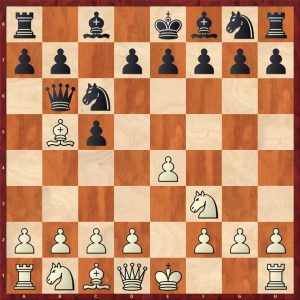
Borgov replies 4.a4 and wins a good game.
However, the author recommends the more natural 4.Nc3

4…e6 4…g6 5.d4!

4…Nf6 5.e5 Ng4 6. Bxc6

6…bxc6 (6…dxc6 7.0-0 g6 8.Re1 Bg7 9.h3 Nh6 10.Ne4 0-0 11.d3 with a huge edge) 7.h3 Nh6 8.0-0 Nf5 9.Na4 Qa5 10.b3 followed by 11.Ba3 with a massive advantage.
5.Bxc6! Qxc6 6.d4 cxd4 7.Nxd4

White has a significant lead in development which is definitely more important than the bishop pair.
7…Qc7 8.0-0 a6 9.Re1
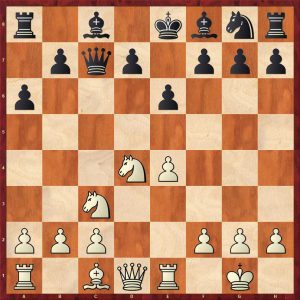
White has a healthy lead in development. Now there are ideas of Nd5 and Nf5
9…d6 10.Bf4!

10…e5 11.Nd5 Qd8
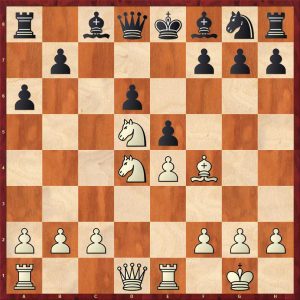
12.Nf5!?
12.Be3 is the positional continuation which is also good, a possible continuation is 12…Nf6 (12…exd4? 13.Bxd4 followed by Bb6 and Nc7+ exploiting the weak dark squares) 13.Ne2 Nxd5 14.Qxd5

14…Qc7 15.Qd2 Be7 16.Nc3 Be6 17.Nd5! Bxd5 18.Qxd5 and white has a pleasant positional edge.
12…exf4 13.Qd4!

13…Ne7 (13…Nf6 14.Nb6 Be6 15.Nxa8 Qxa8 16.e5 dxe5 17.Qxe5 Rg8 18.Rad1 winning) 14.Nxg7+ (Stockfish prefers 14.Nf6+ gxf6 15.Nxd6+ Qxd6 16.Qxd6 Ng6 17.Qxf6 Be6 18.Rad1 Be7 19.Qg7 Rc8 White has a queen and 2 pawns for two bishops and knight but black is solid.)
14…Bxg7 15.Qxg7 Kd7 16.Qxf7 Qf8 17.Qxf8 Rxf8 18.Nb6+ Kc6 19.Nxa8 Be6 20.Rad1 Rxa8 21.Rd3 With a superior endgame but black can fight.

Part 2 covers 3…Nf6
After 4.Nc3 this position is reached:

Here we are going to cover 4…e5? which has been played by both Carlsen and Kramnik. The bust is shown by Ravi.
5.Bxc6 dxc6 (5…bxc6 6.Nxe5 Qe7 7.Nf3! Nxe4 8.0-0 winning) 6.Nxe5
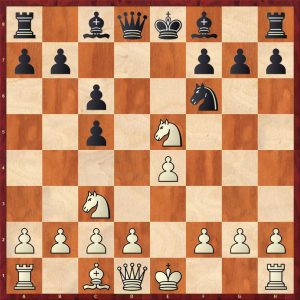
Nxe4 (6…Qe7 7.f4 wins a pawn) 7.Nxe4 Qd4 8.Qe2! Qxe5 9.f4!

9…Qxf4 10.d4 Qh4+ 11.g3 Qe7 12.Bg5!

12…Qe6 13,0-0 h6 14.Rae1! hxg5 15.Rxf7!
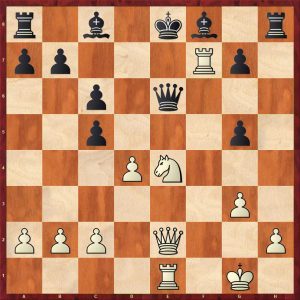
With a winning attack. One possible continuation is 15…Be7 16.Qf2 Qg6 17.Nxg5 Qxg5 18.h4 Qd5 19.Rfxe7+ Kd8 20.dxc5 Bd7 21.R7e5! Qaz2 22.Rd1 winning

For example 22…Re8 fails to 23.Rxd7+
Section 3 covers 3…d6
After these moves:
1.e4 c5 2.Nf3 d6 3.Bb5+ Nc6 4.0-0 Bd7 5.Re1 Nf6 6.c3 a6 7.Bf1 Bg4 8.d4 cxd4 9.cxd4
Here is one of the important positions in this line. Black has a key choice here about which pawn to push to challenge white’s pawn duo in the centre 9…e5 or 9…e5. The two moves lead to significantly different type of positions.

I shall show a variation from 9…d5 10.e5

Black has three knight moves here 10…Ne4, 10…Nd7 and 10…Ng8
After 10…Nd7 white has an interesting pawn sacrifice to disrupt black’s position. 11.e6!

Black can recapture with the bishop or the pawn, after 11…Bxe6 this short line shows the typical dangers for black 12.Nc3 Nf6? A natural move that leads to big problems for black. 13.Rxe6! fxe6 14.g3! How does black defend the e6 pawn and develop?
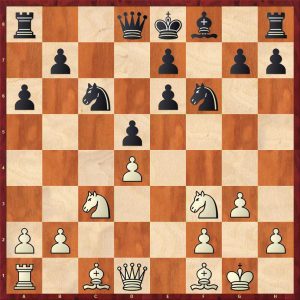
A typical line could be 14…g6 15.Bh3 Bg7 16.Ng5 0-0 17.Nxe6 Qc8 18.Kg2 with a big plus for white who can improve his position further before taking back the exchange.

After 11…fxe6

12.Nc3 the game continued 12…e5?! A desperate freeing move, 12…g6 is much better

This is decisively refuted by 13.Nxd5 Qa5
A pretty line is 13…Nxd4 14.Nxd4! A lovely queen sacrifice, the horses trample over black

14…Bxd1 15.Ne6 Qc8 16.Ndc7+ Kf7 17.Ng5+

17…Kf6 (17…Kg6 18.Bd3+ e4 19.Bxe4+ Kh5 20.Nxa8 winning)18.Nd5+ Kg6 19.Bd3+ Kh5 20.Rxd1 winning

The king will be mated after h3 and g4 whilst black’s sleeping army looks on.
Back to the game: 14.Bc4 Bxf4 15.gxf3 e6 16.Bd2 Qd8 17.Nf4! with a huge attack.

Section 4 covers 3…e6 which is one of the main continuations. The author gives two distinct variations here: 4.0-0 followed by d4 or the slower 4.0-0 followed by 5.Re1.
Here is a smooth game by Magnus Carlsen against Boris Gelfand in the second system suggested.
Magnus Carlsen (2872) – Boris Gelfand (2740)
FIDE Candidates London (10) 27.03.2013
1.e4 c5 2.Nf3 Nc6 3.Bb5 e6 4.0-0 Nge7 5.Re1 a6
6.Bf1 d5 7.exd5 Nxd5 8.d4 Nf6 9.Be3

9…cxd4 (9…Nd5 has been tried 10.Bg5! The critical move 10…f6 11.Bc1! (11.c4!? is also slightly better for white) 10.Nxd4

10…Bd7 (10…Nxd4 11.Bxd4 Be7 12.a4!?)

With the idea of Na3 and Nc4 leading to a slight edge for white.
11.c4

This is the idea. White has a bit more space and a queenside majority. Black of course has a healthy and solid position though. 11…Nxd4 (11…Be7 12.Nc3 0-0 13.Nf3!? White has been quite successful with this move, and this is an argument for Gelfand’s choice, securing relieving exchanges before it is too late.;
11…Bb4!? is simply wrong: 12.Nc3

Bxc3 13.bxc3 0-0 14.Nb3 White’s activity and powerful dark squared bishop more than compensates for the structural weaknesses. 12.Bxd4 Bc6 13.Nc3 Be7 14.a3!?

a5!? (14…0-0 15.b4 is what White wants, but as usual only a slight edge.) 15.Qd3 0-0 (15…a4?! is an ambitious attempt, but after 16.Rad1 0-0 17.Qg3 White’s initiative is powerful)

16.Rad1 The author likes 16.Nb5! exploiting the hole, after 16…Bxb5 17.cxb5 white has the bishop pair but black has d5 for the knight.

16…Qc7 16…a4 17. Qg3! Qb8 18.Nd5!
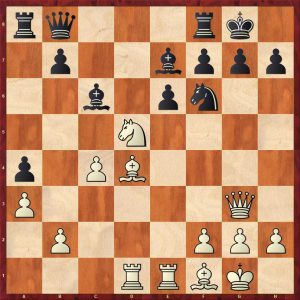
17.Be5 Qb6 18.Qg3 Rfd8 19.Rxd8+ Qxd8 20.Rd1
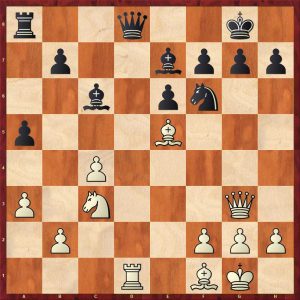
Qb6 [20…Qf8!? this defensive move is better, after 21.Bd3!? White remains comfortably placed.] 21.Bd4 Qb3 22.Rd3 22…Qc2 23.b4! axb4 24.axb4 Nh5 25.Qe5 Bf6 26.Qxh5 Bxd4 27.Rxd4 Qxc3 28.Qa5! The point behind 23.b4, without this, White wouldn’t even be better. But now with this intermezzo, White just manages to coordinate in time, and thus his queenside majority secures a huge edge. 28…Rf8 29.Qb6 White went on to win a nice game.

Section 5 covers 3…g6 which is arguably the critical continuation. The author offers two different systems against this line: either capturing on c6 immediately or playing 4.0-0 and 5.c3.
Here is an instructive game using the first suggested system which is a superb win by Michael Adams over Vladimir Kramnik in 2000, which was played just before Kramnik defeated Garry Kasparov for the Classical World Chess Championship.
Michael Adams (2755) – Vladimir Kramnik (2770)
Dortmund Super GM (4), 10.07.2000
1.e4 c5 2.Nf3 Nc6 3.Bb5 g6 4.Bxc6

Black’s has a major decision here on which way to recapture the bishop. The recapture with the b-pawn is more aggressive.
4…dxc6 5.d3 Bg7 6.h3 Nf6 7.Nc3

A key early position in this line. Black normally arranges to play e5 here to increase his share of the centre. There are essentially three different ways to do this. Kramnik chooses the direct route with a standard knight manoeuvre to d7 to support the e5 advance. This knight is then often routed round to d4 via f8 & e6.
7…Nd7 8.0-0 e5 Preventing d4 for the time being 9.Be3 0-0

A tabiya in this line.
Ravi accompanies this diagram with some typical erudite advice about white’s plans here:
“It’s worth taking a step back and understanding what we’re playing for. As Black has castled quickly, he’s signalled that he doesn’t mind us playing Be3, Qd2 and Bh6 – in an attempt to exchange off the dark-squared bishops. The resulting positions will always be slightly better for White, but Black will maintain that he’s very solid. As there are often a great deal of possibilities, I’ve elected to show some model games rather than analyse endless variations- but the model games are excellent in demonstrating key ideas in these lines. Our plan usually remains the same – exchange off dark-squared bishops, attempt to create a queenside weakness with a2-a4, and at the right moment push f2-f4, possibly entering into an endgame if circumstances are favourable.”
10.Qd2 Re8 11.Nh2
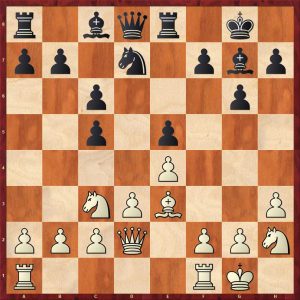
White’s position is harmonious and certainly easier to play. He has a lead in development as black has yet to activate his queenside. The bishop pair is not really an advantage in this type of position, but black is hoping that the bishop pair will be a long term factor. White has three minor pieces to exploit the weakened black squares on black’s kingside whereas black has only two to defend them.
11…Qe7 (11…b6 has been played in many correspondence games 12. Bh6 Bh8 13. Rae1 a5!? 14.Nd1!

An excellent repositioning suggested by the author to improve the horse, followed by Ne3 and f2-f4) 12.Bh6 Bh8
Black keeps this bishop, 12…Nf8 is an alternative but the author demonstrates with two example games how quickly black can succumb with his weakened kingside. The reviewer will showcase one of these games. 13. Bxg7 Kxg7

The obvious move 14.f4 is good here, as well as Robin Van Kampen’s 14.Ne2. Stockfish prefers 14.f4 and gives 14…gxf4 15.Rxf4 Ne6 16.Rff1! avoiding the queen exchange after 16…Qg5 17.Qf2! as pointed out by Ravi. After 14.Ne2 Ne6 15.Kh1 b6 16.a4! Classy play creating queenside weaknesses.

16…a5 17.b3 Ra7 18.f4! exf4 19.Nxf4 Nxf4 (19…Nd4 looks better retaining the good knight) 20.Rxf4

This position is much better for white as black’s dark squares are weak and his bishop is snuffed out by white’s superb pawn structure. White’s rooks will also be very active on the half open f-file. It’s not surprising that black collapsed quickly. 20…Qe5 (20…f6 21. Raf1 Rf8 22. Qc3 white is clearly better: 23. Nf3 followed by e5 looks good) 21.Raf1 Kg8 22.Rf6!Be6 23.Qh6 Qd6 24.Nf3 Qf8 25.Qf4 Rd7 26.Ne5 winning

13.Ng4

13…Nf8 (13…Nf6 14.f3! Nh5 15.Ne2! Nf4 16.Nxf4 exf4 17.c3 g5 18.h4 f6 19. g3!)

Black’s position is crumbling on the dark squares.
14.Bg5! A typical probing move

14…f6 15.Nh6+ Kg7 16.Be3 Ne6

The author suggests 17.Rae1 as an improvement athough Stockfish likes 17.Kh1 as well.
17.Ne2 Ng5

18.Ng4 (18.f4! also leads to a white advantage 18…exf4 19.Bxf4 Kxh6 20,h4) 18…h5 (18…Bxg4? is a positional mistake, see Leko-Van Wely Monte Carlo 2003) 19.Nh2

Although white’s knight has been pushed back, black has had to weaken his kingside to do this. This is exploited neatly by Adams. As Arnie says, “I’ll be back”.
19…Rd8 20.Qc3 Ne6 (Finally completing the manoeuvre started on move 7) 21.f4 Nd4 22.Rae1 Kh7 23.Nf3 Be6 24.fxe5 fxe5 25.Ng5+ I’m back! White is more comfortable here but black can hold. His super knight on d4 is the pride of his position.

25…Kg8 26.Nxe6 removing the better bishop 26…Nxe6 White has a definite edge here, but black is solid. Adams went on to outplay Kramnik in this position.
In summary, this is an excellent book which will give any white player a very good grounding in the Rossolimo Variation. All the major variations are covered with a significant number of original suggestions and analysis. Buy this book !
The reviewer is looking forward with great interest to the next volumes in Ravi Haria’s Anti-Sicilian series. I am guessing that he will cover the Moscow Variation 3.Bb5+ against 2…d6. I am intrigued as to what the author will suggest against 2…e6.

FM Richard Webb, Basingstoke, Hampshire, 18th July 2021
Book Details :
- Hardcover : 280 pages
- Publisher:Thinkers Publishing; 1st edition (28 Jan. 2021)
- Language: English
- ISBN-10: 9464201053
- ISBN-13: 978-9464201055
- Product Dimensions: 17.02 x 23.5 cm
Official web site of Thinkers Publishing

